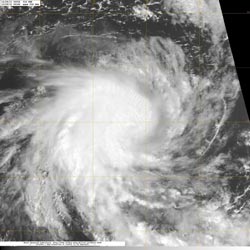NASA Sees Birth of First Southern Indian Ocean Season Tropical Storm

The MODIS instrument on NASA's Aqua satellite captured an image of Tropical Cyclone 01S on Dec. 5 at 08:18 UTC (3:18 a.m. EST) in the Southern Indian Ocean. Strong thunderstorms are visible around the center as they cast shadows on the lower surrounding clouds.<br>Credit: NASA/NRL <br>
Tropical Cyclone 01S (TC01S) formed today December 5, 2011. TC01S has maximum sustained winds near 55 knots (63 mph/102 kmh) and is rapidly consolidating and organizing, so strengthening is forecast. At 0900 UTC (4 a.m. EST) on Dec. 5, TC01S was located about 545 nautical miles west of the Cocos Islands near 12.2 South and 87.0 East. It was moving to the west at 7 knots 8 mph/13 kmh).
The Moderate Resolution Imaging Spectroradiometer (MODIS) instrument on NASA's Aqua satellite captured an image of Tropical Cyclone 01S on Dec. 5 at 08:18 UTC (3:18 a.m. EST) in the Southern Indian Ocean. Strong thunderstorms are visible around the center as they cast shadows on the lower surrounding clouds.
Microwave satellite instruments showed an eye developing in TC01S. There is also tightly curved banding of thunderstorms around the low-level center. T01S has intensified rapidly over the first 12 hours of its existence. The Joint Typhoon Warning Center forecasters expect TC01S to strengthen to hurricane-force over the next two days and track to the southeast, staying at sea.
Text credit: Rob Gutro
NASA's Goddard Space Flight Center, Greenbelt, Md
Media Contact
More Information:
http://www.nasa.govAll latest news from the category: Earth Sciences
Earth Sciences (also referred to as Geosciences), which deals with basic issues surrounding our planet, plays a vital role in the area of energy and raw materials supply.
Earth Sciences comprises subjects such as geology, geography, geological informatics, paleontology, mineralogy, petrography, crystallography, geophysics, geodesy, glaciology, cartography, photogrammetry, meteorology and seismology, early-warning systems, earthquake research and polar research.
Newest articles

Webb captures top of iconic horsehead nebula in unprecedented detail
NASA’s James Webb Space Telescope has captured the sharpest infrared images to date of a zoomed-in portion of one of the most distinctive objects in our skies, the Horsehead Nebula….

Cost-effective, high-capacity, and cyclable lithium-ion battery cathodes
Charge-recharge cycling of lithium-superrich iron oxide, a cost-effective and high-capacity cathode for new-generation lithium-ion batteries, can be greatly improved by doping with readily available mineral elements. The energy capacity and…

Novel genetic plant regeneration approach
…without the application of phytohormones. Researchers develop a novel plant regeneration approach by modulating the expression of genes that control plant cell differentiation. For ages now, plants have been the…





















